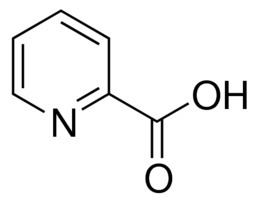Formula C6H5NO2 | ||
 | ||
Appearance White to tan crystalline solid | ||
Picolinic acid is an organic compound with the formula C5H4N(CO2H). It is a derivative of pyridine with a carboxylic acid substituent at the 2-position. It is an isomer of nicotinic acid, which has the carboxyl side chain at the 3-position. It is a white solid that is soluble in water.
Contents
In synthetic organic chemistry, has been used as a substrate in the Mitsunobu reaction and in the Hammick reaction.
Coordination chemistry
Picolinic acid is a bidentate chelating agent of elements such as chromium, zinc, manganese, copper, iron, and molybdenum in the human body. Many of its complexes are charge-neutral and thus lipophilic. After its role in absorption was discovered, zinc dipicolinate dietary supplements became popular as they were shown to be an effective means of introducing zinc into the body.
Production
Picolinic acid is formed from 2-methylpyridine by oxidation, e.g. by means of potassium permanganate (KMnO4).
Biosynthesis
Picolinic acid is a catabolite of the amino acid tryptophan through the kynurenine pathway.
It is a precursor to the coenzyme NAD+. In addition, it is suggested to assist in the absorption of zinc(II) ions and other divalent or trivalent ions through the small intestine.
